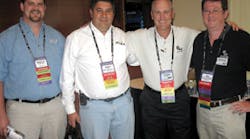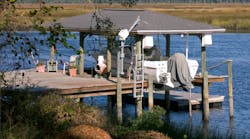Debuting at the Sheraton Towers in Chicago June 25-28, the BICSI Link Workshops catered to nearly 1,000 attendees and visitors. Having two national conferences in Orlando and Las Vegas each year gives BICSI an opportunity to offer this third national meeting with a broader educational focus. This inaugural Link meeting presented 32 workshops within four educational tracks, including data centers, security, wireless, and diverse business management — each having four sessions per day for two days.
At the opening general session, BICSI President John Bakowski announced the recent approval of a strategic plan by the board of directors. Partnerships have been signed with InfoComm International and the Telecommunications Industry Association (TIA) to achieve mutual benefits. Bakowski also noted that BICSI is considering a friendship agreement with U.S. Connected Communities Association (USCCA) and is exploring education and training programs with the United Telecom Council (UTC).
Following are highlights from each of the four workshop tracks featured at this year's event.
Data centers. At a time when firms are investing millions of dollars to bring new data center capacity online that can deliver business and consumer applications at faster speeds, IT executives are challenged to reduce capital and operating expenditures. Thus, attendees learned about the new TIA/EIA-942 standard, which provides guidance on designing and building a date center and is mainly focused on the cabling system and pathway needs of these facilities.
Attendees also reviewed marketing information that revealed large businesses with growing data centers face difficult challenges. Hoping to conserve valuable space, companies are turning to compact blade servers, which fit more chassis into a single, freestanding enclosure. In the past, the average power dissipation in an enclosure was from 1.2 kW to 2.4 kW. Today, a fully loaded blade server enclosure can reach 18 kW.
With the increased amount of power to be delivered and dissipated, data center managers are studying the desirability of having a large quantity of cable under the raised floor and behind each cabinet or enclosure. Thus, attendees learned about the variety of data center design options that can handle this increased heat load.
Some basic rules to follow include: (1) Make efficient use of floor space, (2) Distribute the servers so that all the heat loads are not concentrated in one area, (3) Manage available power, circuit utilization and cooling capacity by area of the room, (4) Make a realistic estimation of future growth and expansion of the facility.
Since the data center is the heart of a data network and downtime is not acceptable, the use of a structured optical cable system was also reviewed. Because optical cabling offers error-free data transmission and facilitates the inevitable moves, adds, and changes, an optical cable plant can also ease the migration to higher data rates, such as 10Gb/s and beyond. Additionally, the use of optical fiber in a storage area network (SAN) is increasingly important, as software changes from a PC server-based resource to a Web-based service.
Security. Security management, an increasingly important topic in the post-9/11 world, requires the participation and cooperation of many people in an organization. Everyone from management to data entry personnel must be aware of the restrictions regarding access to the network, use of passwords, security clearances to certain areas of a building, changes to the cabling system, and more.
One presentation focused on network security and the instructor discussed how a network manager could incorporate a multilevel approach using standards-based protocols such as transport layer security (TLS), secure sockets layer (SSL), RADIUS, TACACS, port security, and intrusion detection.
Increasingly, security systems are moving into the network infrastructure BICSI members are currently designing and installing. In fact, many BICSI contractors have already been asked to pull the cable for these installations or to provide a complete solution. In addition, voice/data contractors are more apt to use alternate transmission methods (unshielded twisted pair or fiber systems) that can lower costs or improve the quality of installation, when compared to the security contractor.
For visual monitoring of a facility, the use of IP video surveillance is relatively new to the market and is gaining wide acceptance. In a typical IP-based system, network cameras are connected directly to the LAN and transport digital video across the IP network via UTP cabling and switches, recording video to any PC or server on the network.
Attendees learned about digital video recorders (DVR), which store images on a hard drive rather than on videotape. In this tutorial, attendees were told how to properly size the hard drive serving the video monitoring system.
Wireless. Municipalities are continuing their push to provide high-speed wireless services to government and citizens. These agencies are deploying mobile and fixed wireless broadband networks to connect government buildings, municipal vehicles, traffic signals, and video cameras, thus providing efficiencies and reducing telecommunications expenditures.
Attendees learned how some health care facilities are widely deploying wireless systems to bring patient care records to a doctor and nurse at a bedside. In addition, IT functions in a medical facility can also be intimately tied to clinical decision support tools, thus achieving customized care that could facilitate longer remissions and better monitoring of ongoing medical conditions. The presenter noted that health care facilities, unlike others, are positioned to benefit the most from multiple wireless systems within the facility.
Site analysis is needed to properly locate the access points for adequate coverage, since the wireless access points are simply extensions of a properly designed structured wiring system in a building or outdoor area.
One presenter discussed the relationship between WI-FI, in-building cellular phone coverage, and RFID inventory tagging systems.
Having local service and support that is knowledgeable about an IP telephone system, along with power and cooling protection, is critical, since existing IT network protection may not be adequate for an IP telephone system. Equipment also plays a role in making repairs easier. For instance, a maintenance bypass switch for the UPS lets service personnel work on the UPS without a shutdown of the IP telephone gear.
Understanding the IEEE 802.3af standard for Power over Ethernet (POE) was also a major topic in the section of the workshop. PoE refers to the ability to power network devices over the existing data wiring, eliminating the need for an external power supply for each device. With PoE, devices such as wireless access points, IP telephones, IP security cameras, and other terminals can receive power from the existing installed cable without any change to the cabling system.
Although initially developed for the Voice over Internet Protocol (VoIP or Internet Phone), the standard was expanded to accommodate other devices, with the wireless access point being a major user.
Under the standard, PoE injects balanced currents into two of the four cable pairs. A PoE-powered switch inserts power on the pairs that carry data (pins 1-2 and 3-6). A midspan device places power on the normally unused pairs (pins 4-5 and 7-8).
Diverse business management. This track consisted of a number of related subjects, including: understanding how to apply the National Electrical Code; use of the ANSI/TIA/EIA-606-A standard pertaining to the labeling of a structured cabling system; understanding three types of physical outside plant designs, along with their application and components; the tools and techniques of project management in various segments of the telecommunications industry; and securing an SBA loan.
Something for everyone. From facility owners to electrical contractors to architects to consultants, the Link Workshops offered exclusive information on a variety of topics. By allowing attendees to mix and match sessions, creating their own specialized schedule of education, the event offered practical, hands-on information that could be applied immediately once participants returned back to work. In addition, the exhibits gave them the opportunity to network with professionals from all over the world, ranging from manufacturers to practitioners to end-users. The Link Workshops also fulfilled the conference/workshops attendance requirement for RCDD renewal — providing 15 continuing education credits (CECs) to all RCDDs in attendance.




